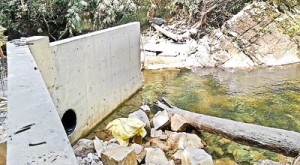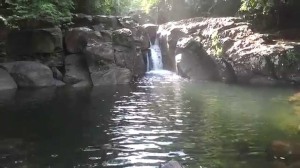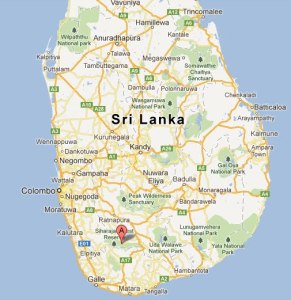In Sri Lanka large hydro power potential has been fully utilised. There is no space to add in more plus the existing schemes are multi purpose, providing necessary irrigation water especially to the semi dry and dry zones. And this places a further limit on the capacity of Sri Lanka to generate additional electricity from major H.E.P. schemes
However, there are opportunities for the development of privately owned small scale or mini hydro schemes which could add power to the national grid in Sri Lanka. The problem is that these schemes are causing concern amongst environmentalists because they block streams and threaten the environment of fresh water fish and fragile riverine ecosystems.
The Energy situation
The Sri Lankan government has ambitious plans to achieve high rates of economic growth in the coming years. However, Sri Lanka barely generates enough energy to satisfy the demands both domestic and industrial right now. To make matters worse, existing power supply has been plagued by disruptions and power outages in the last few months.
Since coming online the thermal power station at Norochalai on the east coast has had several reported breakdowns including a fire, a leak, a trip and an instance where generation exceeded design levels, causing a shutdown. The most recent shutdown came in March when an explosion in a stepdown transformer caused an island-wide power outage.
It doesn’t help levels of confidence in the electricity generation system to read Sri Lanka’s deputy minister for power and renewable energy, Ajith Perera, saying that the plant had been built with “outdated” technologies and substandard materials.
Add in the continuing debate over whether the next thermal power station at Sampur should be built and it is understandable that the authorities would consider additions to the grid from privately owned hydro electric power generation which is both clean and renewable.
Enter the mini hydroscheme
A mini hydro project works by having water in a river diverted to a powerhouse by means of a dam built across the flow. This water rotates a turbine and flows back downstream. Not all the water can be diverted: a part has to be let flow naturally in the river, according to law.
reprinted with permission by Malaka Rodrigo
reprinted with permission by Malaka Rodrigo
The advantages to the state seem obvious.
- The south west of the island is an area of high rainfall so projects such as this provide a clean and renewable source of energy
- the state is not involved in any outlay of funds but can simply opt to buy in power from the private company
- the scale of the development is small which should minimise environmental impact
However, this form of clean energy comes at a cost;
- alterations to the river flow have an impact on the physical hydrology of the river changing the volume and velocity of flow downstream, changing the river load and so impacting river channel processes, often increasing erosion downstream of the dam
- changes to the river have an ecological impact on both flora and fauna
- there is often damage to the environment from trucks and during construction destroying pristine environments and habitats
Add to that the question of whether the state should be reliant on private companies for additional power generation when their main motive in building these schemes is arguably profit above any other consideration, including the environment
Some tea estates up in the hills already operate their own private schemes providing power to the tea factories. Theses schemes are generally not taking place in environmentally sensitive areas and are not the focus of this article. What is of concern is applications to develop mini hydro schemes in environmentally sensitive areas such the Sinharaja rainforest reserve.
Case Study
The proposal to build a mini hydro plant at a waterfall and beauty spot is posing a real threat to Athwelthota river; home to 39 freshwater species 19 of them endemic to Sri Lanka.
source Youtube
The Athwelthota is one of many rivers that flows out from the northern flanks of the Sinharaja rain forest reserve in southern Sri Lanka. Sinharaja is a world heritage site, and the country’s last viable area of primary tropical rainforest. More than 60% of the trees are endemic and many of them are considered rare. There is much endemic wildlife, especially birds, but the reserve is also home to over 50% of Sri Lanka’s endemic species of mammals and butterflies, as well as many kinds of insects, reptiles and rare amphibians.
source Google sites
Athwelthota is a paradise for freshwater fish, with a number of species discovered in this unique habitat. The CEJ and the Wildlife Conservation Society of Galle (WCSG) have published a poster showing the indigenous fish that could be endangered by the proposed mini-hydro project in Pilithudu ella, Morapitiya-Athwelthota.
If a mini hydro plant is built, some believe that the change in flow will be a death sentence for many species living in this micro-habitat,
- Different fish need different micro-habitats, . For example, the gal padiya or sucker fish lives deep in fast-flowing water; some fish species live in relatively calm water while others prefer fast-flowing water.
- But if part of a stream is diverted the habitat downstream changes and fish will be affected even though a percentage of water might be allowed to flow freely.
- With flow changes the PH value of water too could change and very sensitive species could become affected.
- Some fish migrate upstream to breed and when the stream is blocked this movement is disrupted,
In Athwelthota, 39 freshwater species have been recorded, 20 of them endemic to Sri Lanka.
Most of the mini-hydro projects are being constructed in the biodiversity rich wet zone, so the damage they cause is actually worse than with the large dams, Not only the fish but other animals such as amphibians and freshwater crabs too are affected.
Athwelthota is also home to Sri Lanka’s only aquatic orchid. Near a waterfall lies a special “spray zone” full of water vapour and this special habitat could be totally lost,
Overall 37 projects are under consideration/construction; many in or on the boundaries of the Sinharaja Rain Forest Reserve.
Construction is being carried out in the Northern Sinharaja Rainforest buffer zone at Kosgulana, approximately 4km east from the Kudawa main entrance. A dam is being built blocking the Kosgulana river in Sinharaja buffer zone and several acres of rainforest have been cleared and concrete laid along the once pristine and protected riverbank. Large trucks and machinery used for construction have driven a wide track through what was once a small footpath in the Sinharaja buffer zone, between Kudawa and Kosgulana,
Another project in the rain forest where 2.5km of concrete penstock has been constructed in the Dellawa district is also said to be “causing massive environmental destruction to the stream, the wildlife and the forest The mini-hydro project will destroy a total 6.5 km stretch of the Anda Dola as water is being diverted from the weir to the powerhouse, several kilometres away. This will result in the local extinction of many endemic and endangered fish species recorded in the Anda Dola.
and what impact might this have on tourism going forward.. not everyone wants to dump themselves on a beach for two weeks…
Final thought
Sri Lanka as a country is changing. With the new government there is a greater concern for the environment and a growing resistance on the part of environmentalists to the power of local politicians and businessmen who have been allowed to ignore the environmental laws of the country. It will be interesting to see how successful they are going forward.
In any case micro hydro schemes are not the answer to Sari Lanka’s growing energy problem. Put together they will not generate the additional power needed. Neither can the island continue to afford to import large amounts of oil to generate power.
Maybe that does mean going ahead with the Sampur coal fired power station in spite of all the objections. Or maybe the government and its foreign funding partners should be looking much more seriously at wind power and solar power as alternatives rather than dumping outmoded and dirty technology on an unsuspecting population.
Acknowledgement: I am grateful, as ever, to Malaka Rodrigo for allowing me to take much of the above from his excellent article: Mini hydros; clean energy comes at a high cost to nature featured in his blog: Window to Nature
You should also read his latest blog which is a follow u on the first one at





One thought on “Mini Hydro Schemes; threatening Sinharaja”